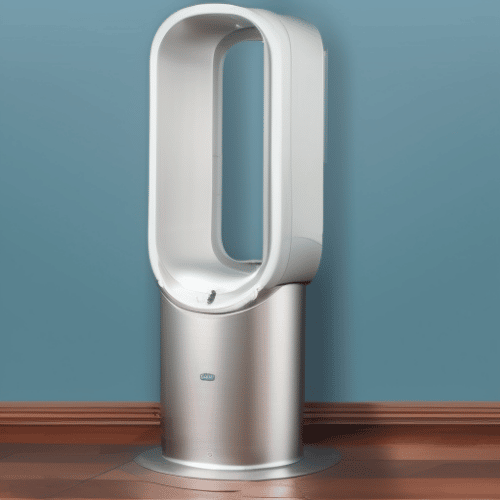Last Updated on
Are you looking for an interesting way to stay cool this summer? Why not try your hand at making a bladeless fan? It may sound like something out of a science fiction movie, but it’s actually quite easy to make. With just some basic materials and tools, you can craft yourself a unique DIY fan that will keep the air in your home or garden fresh and comfortable. In this blog post, we’ll show you step-by-step how to make a bladeless fan so get ready – let’s get started on our own little project.
Table of Contents:
- Gather Your Materials
- Attach the Motor
- Install the Blades
- Test It Out
- FAQs in Relation to How to Make a Bladeless Fan
- Conclusion
Gather Your Materials
Are you ready to build a bladeless fan? Before you get started, it’s important to gather all the materials and tools that you’ll need. This will help ensure that your project runs smoothly and efficiently. Here is a list of what you should have on hand:
Tools:
• Screwdriver – You’ll need this for attaching the base of the fan to its stand. Make sure it has interchangeable heads so that you can use different sizes of screws as needed.
• Pliers – These are necessary for tightening nuts and bolts during assembly.
• Wire cutters – If your fan kit includes any electrical wiring, these will come in handy for cutting off excess lengths or snipping away insulation from wires.
Materials:
• Fan body – The main part of the bladeless fan which houses all the components like blades, motor, etc., usually comes with its own mounting bracket or stand included in most kits.
• Blades/Fan cover – Depending on your model, this could be either plastic or metal blades encased in a protective cover made out of plastic or metal mesh material. • Motor/Electrical parts– Motors vary depending on size and power requirements but generally include an electric cord with a plug-in adapter along with other small electrical components such as capacitors and resistors if applicable. • Mounting hardware– This includes screws, nuts & bolts used to attach both the base and blade covers onto their respective stands/brackets securely when assembling your bladeless fan unit together correctly.
Once you have all the materials you need, it’s time to start assembling the base of your bladeless fan – an important step in making sure your fan is safe and secure.
Attach the Motor
Once you have gathered all of your materials, it’s time to assemble the base. Make sure that everything is securely fastened together before moving on to attaching the motor. Once this is done, attach one end of your power source to a wall outlet or other electrical source and plug-in the other end into your motor.
Now comes the tricky part:
Connecting up your wires correctly so that they are properly grounded and secure against short-circuiting when powered up. If you’re unsure about how to do this safely, consult with a qualified electrician who can advise you further – better safe than sorry.
Next up is mounting your motor onto its base using either screws or bolts depending on what type of material was used for construction (e.g., wood versus metal). Ensure that each screw/bolt has been tightened securely so there’s no risk of movement during operation – if something does come loose later down the line then it could cause serious damage both to yourself and any surrounding property.
Finally, check over everything once more before powering up – double-check connections between wires as well as those between power sources and motors just in case anything has come undone while assembling them earlier on. And voila – once everything looks good then switch it on and enjoy watching your new creation work away happily ever after.
Now that the motor is securely attached, it’s time to install the blades and get your bladeless fan up and running.
Install the Blades
Installing blades correctly is essential for maximising airflow and preventing damage. Here are a few steps to help you get the job done right:
1. Measure Twice, Cut Once:
Before cutting any material, make sure you measure twice and cut once. This will ensure that your cuts are accurate and the blades fit properly in their designated slots.
2. Wear Protective Gear:
When installing blades, it’s important to wear protective gear such as safety glasses or goggles, gloves, long sleeves/pants, and closed-toe shoes to protect yourself from potential injury due to sharp edges or flying debris.
3. Secure Blades With Fasteners:
Use fasteners such as screws or bolts to secure the blades in place so they don’t move around during operation of the fan or come loose over time due to vibration caused by air movement through them. Make sure these fasteners are tightened down securely but not too tight so they don’t cause any damage either.
It is recommended to balance your blades using a blade balancer tool prior to installation, when possible. Doing so can help reduce noise levels and improve efficiency by ensuring air moves evenly across the surface area of each blade without causing turbulence that could potentially lead to premature wear & tear on other components within the system. Properly balancing your fan’s blades will also make sure you get optimal performance from it over time.
It is essential to check clearance levels around the blades in order to ensure that there is adequate space between them and any nearby objects, both static (e.g. furniture or decorations) and dynamic (e.g. people walking past). This will prevent contact which could potentially cause damage during the operation of the fan system, while also helping you achieve optimal performance over time by avoiding turbulence that may lead to premature wear & tear on other components within it.
Lastly, always follow manufacturer instructions carefully when installing new fans or replacing existing ones. Failure to do so can result in improper installation which could lead to reduced performance levels and increased risk of personal injury due to incorrect use or installation methods being employed.
Once the blades are securely in place, you can move on to testing out your new bladeless fan and make sure it’s working properly. Let’s take a look at how to do that in the next step.
Test It Out

Testing out your new bladeless fan is an exciting moment. But it’s important to do so safely and correctly. Before you plug in the fan, make sure that all of the components are securely attached and tightened. Once everything looks good, you can go ahead and plug it in.
Start by turning on the power switch located at the base of the fan. You should hear a faint humming sound as soon as you turn it on; this indicates that electricity is flowing through your device properly. If there is no sound or if something sounds off, unplug immediately and double-check all connections before trying again.
Next, adjust the speed settings to see how they affect airflow from your bladeless fan. Start with low speed first then gradually increase until you find a comfortable setting for yourself or others around you who may be using it too. Make sure not to exceed the maximum speeds recommended by manufacturers as doing so could cause damage to internal parts over time or even lead to injury if someone were to come into contact with fast-moving blades while cleaning up after use.
To ensure you get the most out of your bladeless fan, take some time to explore any additional features it may have. Oscillation will enable air flow from side to side instead of just straight forward, which can be more effective in cooling larger areas. Remote control capabilities provide users with greater flexibility when controlling their fans without having to physically move around each time adjustments need made – a convenient option for those hot summer days where getting up is not always an option but staying cool still needs to be achieved.
Finally, once you are satisfied with the performance levels achieved during testing phases, you can enjoy using your new bladeless fan knowing that everything was checked thoroughly beforehand to ensure safe operation every single time.
FAQs in Relation to How to Make a Bladeless Fan
How does a bladeless fan work?
A bladeless fan is a type of electric fan that uses an air multiplier technology to draw in and amplify surrounding air, creating a powerful stream of smooth airflow. This technology works by using an annular aperture (a ring-shaped opening) located at the base of the fan. The annular aperture draws in surrounding air which is then accelerated through an airfoil-shaped ramp inside the unit. This creates a jet of high-velocity airflow from the centre of the fan, providing cooling relief without any blades or visible moving parts. The air multiplier technology also allows for a more energy-efficient fan as it requires less power to generate the same amount of airflow compared to traditional fans.
What type of material is a bladeless fan?
A bladeless fan is a type of electric fan that uses air multiplier technology to create a smooth, uninterrupted airflow. It works by drawing in surrounding air and amplifying it up to 15 times its original speed, producing a powerful yet quiet stream of air. The absence of blades makes the device much safer than traditional fans, as there are no spinning parts or sharp edges. Bladeless fans also offer improved energy efficiency compared to other types of fans due to their efficient design and lack of exposed moving parts.
Conclusion
Learning how to make a bladeless fan is an easy and fun DIY project that can be done in just a few hours. With the right materials, you can have your own custom-made fan to keep cool during hot summer days. All it takes is some patience and creativity to make a bladeless fan of your own. So why not give it a try? You’ll be glad you did.
Paul is the type of person who never met a problem he couldn’t fix. He can always be found tinkering with something in his house, even if it isn’t broken! His tips and tricks are often shared on our site. He’s the one you call when something breaks because he has been known to improvise fixes for everything from leaky faucets to malfunctioning dryers.



